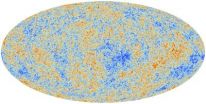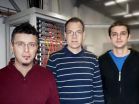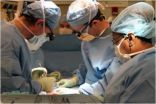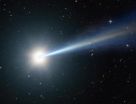(Press-News.org) "We are very excited, we are finally seeing the concrete results of so many years of hard work". This is how the scientists of the Planck project have commented the first data resulting from the observations carried out by Planck. The mission of the ESA satellite is to observe the past of our Universe, going back in time and reaching the very first instant right after the Big Bang. The image that the Planck scientists convey today is that of a 'child' Universe, dating back to about 380,000 years after the Big Bang, when its temperature was similar to that of the most external layer of a star today.
The Planck satellite, the result of the collaboration of several European aerospace agencies including the Italian one (ASI), was launched in May 2009. From that moment onwards it has been endlessly observing the Universe's fossil radiation. In Trieste scientists have analyzed data delivered by the LFI (Low Frequency Instrument), the instrument that detects the radiation within the 30 to 70 GHz interval. The Trieste team, which comprises SISSA and INAF-Osservatorio Astronomico, with the collaboration of Università di Trieste, has contributed to the drafting of about thirty papers that were published today, 21 march 2013, in the journal Astronomy & Astrophysics.
"The maps we have obtained feature levels of resolution and sensitivity never achieved before, a milestone in modern cosmology", explains Andrea Zacchei, a researcher at the Osservatorio Astronomico of Trieste who, following Fabio Pasian, is now in charge of the entire data analysis of the LFI. "In a year's time the challenge will be even greater, as we will try to conclude the analysis of polarization data which may give us a few surprises regarding our comprehension of the Universe". The polarization is in fact the "direction" taken by the light, perpendicular to that in which it travels, that "remembers" very well the one that had been impressed on the Big Bang and it may therefore convey very important information.
"The observations carried out by Planck reveal with unprecedented exactness the imprint of the Big Bang on the fossil radiation. This the first time that man can look with such clearness at the origin of our Universe, in which we see the impact of forms of matter and energy still unknown today", adds Carlo Baccigalupi, a cosmologist at SISSA. "In order to comprehend Planck's data we still have to focus on the most mysterious part of the signal, in which we may look for space-time oscillations of cosmological dimension, and such information that may help identify the physical processes that occurred at the time of the Big Bang. A lot of work for scientists for many years to come". The task of Baccigalupi, alongside Luigi Danese, Francesca Perrotta and the SISSA group, is to extract the signal of the Big Bang and the main astrophysical emissions.
More in detail...
Planck is a satellite of the European Space Agency, designed to observe the Big Bang through the cosmic background radiation with unprecedented results.
Planned in the mid-90s, the satellite and the instruments it carries on board have been realized thanks to the huge effort of various European space agencies, while NASA created the cooling system.
Planck carries on board two instruments to observe the sky at several frequencies: the LFI (Low Frequency Instrument), under Italy's responsibility, which detects the radiation in the 30 to 70 GHz interval and the HFI (High Frequency Instrument), under France's responsibility, that observes it in the 100 to 857 GHz interval.
The analysis of the satellite-to-ground data has been carried out at two centers only in the world, Paris and Trieste. Trieste in particular, with SISSA, INAF-Osservatorio Astronomico and Università di Trieste, acts as the Data Processing Centre for the low-frequency instrument. In recent years about fifteen scientists from the three institutes have been collaborating zealously with continuous exchanges with the other Planck collaborators, that include the world's greatest experts in data analysis, computer science, cosmology and astrophysics, amounting to over 200 scientists and technicians.
INFORMATION:
Planck's 'child' universe
The first results of the analysis of the Universe's fossil radiation have been released
2013-03-21
ELSE PRESS RELEASES FROM THIS DATE:
Genetic analysis calls for the protection of 2 highly endangered Portuguese fish species
2013-03-21
The two endangered fish species, Squalius aradensis and S. torgalensis, most generally belong to the Cyprinidae, or the carp family. This is the largest fish, and vertebrate family, formed of freshwater fish with a diversity of more than 2,400 species. The family also has an important economic value as a food source. More specifically, the two species studied are members of the subfamily Leuciscinae, formed of small freshwater fish commonly known as minnows. A new genetic study of the two endangered fish was recently published in the open access journal Comparative Cytogenetics.
S. ...
Genetics, age and ethnicity are risk factors in PCa, say experts
2013-03-21
"Are there genetic risk factors for PCa? Yes, and BRCA2 and HOXB13 are useful for predicting high-risk disease," said Jack Cuzick (GB) president of the International Society for Cancer Prevention (ISCaP), referring to the two genes implicated in high-risk prostate disease. Cuzick gave a report on the Consensus Statement for Prostate Cancer Prevention at the closing plenary session of the 28 Annual EAU Congress held in Milan, Italy from March 15 to 19.
"The goal should be to integrate with other protein markers in order to develop risk-adapted screening algorithms," he ...
Novel insights into the evolution of protein networks
2013-03-21
This press release is available in German.
System-wide networks of proteins are indispensable for organisms. Function and evolution of these networks are among the most fascinating research questions in biology. Bioinformatician Thomas Rattei, University of Vienna, and physicist Hernan Makse, City University New York (CUNY), have reconstructed ancestral protein networks. The results are of high interest not only for evolutionary research but also for the interpretation of genome sequence data. Recently, the researchers published their paper in the renowned journal PLOS ...
Planck challenges our understanding of the Universe
2013-03-21
Planck refines our knowledge of the Universe's composition and evolution
New maps provide excellent evidence for our standard model of cosmology
Planck dates Universe at 13.82 billion years old
Anomalies suggest that Universe may be different on scales larger than those we can directly observe
Most accurate values yet for the ingredients of the Universe, with normal matter contributing just 4.9% of the mass/energy density of the Universe and dark matter making up 26.8% - nearly a fifth more than the previous estimate.
Europe's Planck satellite - a flagship mission ...
What you eat before surgery may affect your recovery
2013-03-21
BOSTON, MA—According to a new study, the last few meals before surgery might make a difference in recovery after surgery. Fat tissue is one of the most dominant components that make up the body, and fat tissue is always traumatized during major surgery.
Researchers at Brigham and Women's Hospital (BWH) found that this direct trauma greatly impacts the chemical balance of fat tissue—chemicals that are known to communicate with nearby and distant organs. In the study, mice that consumed a typical Western, high-fat diet showed an exaggerated imbalanced response. Importantly, ...
Researchers tackle physician challenge of correctly ordering laboratory tests
2013-03-21
(Boston) – A new study involving researchers from the Boston University School of Medicine (BUSM) has identified barriers that clinicians face in correctly ordering appropriate laboratory tests and highlights some solutions that may simplify this process and improve patient outcomes. The study, published in the March 2013 issue of the Journal of General Internal Medicine, was led by Elissa Passiment, EdM, of the American Society for Clinical Laboratory Science and James L. Meisel, MD, associate professor of medicine at BUSM.
Passiment, Meisel and colleagues identified ...
Global nitrogen availability consistent for past 500 years, linked to carbon levels
2013-03-21
MANHATTAN -- A Kansas State University research team has found that despite humans increasing nitrogen production through industrialization, nitrogen availability in many ecosystems has remained steady for the past 500 years. Their work appears in the journal Nature.
"People have been really interested in nitrogen in current times because it's a major pollutant," said Kendra McLauchlan, assistant professor of geography and director of the university's Paleoenvironmental Laboratory. "Humans are producing a lot more nitrogen than in the past for use as crop fertilizer, ...
'Gene Therapy for Human Disease: Clinical Advances and Challenges'
2013-03-21
Philadelphia, PA, March 21, 2013 – The April issue of Translational Research examines the progress and outlook of gene therapy research, with a specific focus on the clinical applicability of gene therapy today. Research articles included in the special issue highlight current studies that, after decades of trial and error, may provide evidence for a clear path of treatment and cure for many diseases. There are more than 1,800 genetic disorders known in humans, and only a small fraction of these can be treated and even fewer cured. Some of these disorders are exceedingly ...
'Sideline quasars' helped to stifle early galaxy formation, says CU-Boulder study
2013-03-21
University of Colorado Boulder astronomers targeting one of the brightest quasars glowing in the universe some 11 billion years ago say "sideline quasars" likely teamed up with it to heat abundant helium gas billions of years ago, preventing small galaxy formation.
CU-Boulder Professor Michael Shull and Research Associate David Syphers used the Hubble Space Telescope to look at the quasar -- the brilliant core of an active galaxy that acted as a "lighthouse" for the observations -- to better understand the conditions of the early universe. The scientists studied gaseous ...
Reward linked to image is enough to activate brain's visual cortex
2013-03-21
Once rhesus monkeys learn to associate a picture with a reward, the reward by itself becomes enough to alter the activity in the monkeys' visual cortex. This finding was made by neurophysiologists Wim Vanduffel and John Arsenault (KU Leuven and Harvard Medical School) and American colleagues using functional brain scans and was published recently in the leading journal Neuron.
Our visual perception is not determined solely by retinal activity. Other factors also influence the processing of visual signals in the brain. "Selective attention is one such factor," says Professor ...
LAST 30 PRESS RELEASES:
Reducing social isolation protects the brain in later life
Keeping the heart healthy increases longevity even after cancer
Young adults commonly mix cannabis with nicotine and tobacco
Comprehensive review illuminates tau protein's dual nature in brain health, disease, and emerging psychiatric connections
Book prepares K-12 leaders for the next public health crisis
Storms in the Southern Ocean mitigates global warming
Seals on the move: Research reveals key data for offshore development and international ecology
Sports injuries sustained during your period might be more severe
World's first successful 2 Tbit/s free-space optical communication using small optical terminals mountable on satellites and HAPS
Can intimate relationships affect your heart? New study says ‘yes’
Scalable and healable gradient textiles for multi‑scenario radiative cooling via bicomponent blow spinning
Research shows informed traders never let a good climate crisis go to waste
Intelligent XGBoost framework enhances asphalt pavement skid resistance assessment
Dual-function biomaterials for postoperative osteosarcoma: Tumor suppression and bone regeneration
New framework reveals where transport emissions concentrate in Singapore
NTP-enhanced lattice oxygen activation in Ce-Co catalysts for low-temperature soot combustion
Synergistic interface engineering in Cu-Zn-Ce catalysts for efficient CO2 hydrogenation to methanol
COVID-19 leaves a lasting mark on the human brain
Scientists use ultrasound to soften and treat cancer tumors without damaging healthy tissue
Community swimming program for Black youth boosts skills, sense of belonging, study finds
Specific depressive symptoms in midlife linked to increased dementia risk
An ‘illuminating’ design sheds light on cholesterol
Who is more likely to get long COVID?
Study showcases resilience and rapid growth of “living rocks”
Naval Research Lab diver earns Office of Naval Research 2025 Sailor of the Year
New Mayo-led study establishes practical definition for rapidly progressive dementia
Fossil fuel industry’s “climate false solutions” reinforce its power and aggravate environmental injustice
Researchers reveal bias in a widely used measure of algorithm performance
Alcohol causes cancer. A study from IOCB Prague confirms damage to DNA and shows how cells defend against it
Hidden viruses in wastewater treatment may shape public health risks, study finds
[Press-News.org] Planck's 'child' universeThe first results of the analysis of the Universe's fossil radiation have been released




